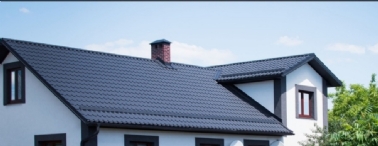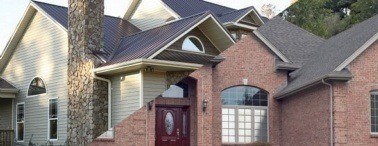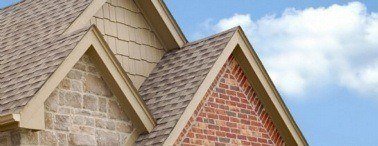
The roof is tied for first at being the most important part of the home. It is the first line of defense against the elements beating out siding and even windows. Because an improperly-installed roof will have a detrimental effect on the structure and seal of the home.
Roof design in any culture calls for the blocking and diverting of water away from the home's structure. Gravity shares the major responsibility for this along with the shape of the roof and the materials used for its make-up. Once the water leaves the roof then it is the job of the gutter system to collect it and lead divert it to an area where it cannot enter the structure.
Roofs today are made of many materials: metal, clay, cement, wood and asphalt shingles. Once of the least expensive roofing materials is asphalt because it is basically a matt of paper or fiberglass soaked in asphalt and encrusted with ceramic granules. The granules are pressed into the surface to provide a hard surface, coloring and to help reflect heat from the sun. Asphalt is not only cheap but it is readily available in a wide variety of colors and weights.
Asphalt Shingle Types
Three-Tab Organic Shingle
This is the standard shingle on most asphalt roofs and comes in a 3 foot strip showing 3 tabs. In most areas they last 20 years or more but, depending on the manufacturer, they come with 20, 25 and 30 year limited warranties. The make up of these shingles is a thin fiber sheet made form paper and/or wood composite. This sheet is then immersed in a soft asphalt cement and then run through a roller presses to form the shingle. Then, it is coated with a heavier asphalt and rolled again.
Next comes the ceramic granule coating which is pressed into the still-hot shingle. A strip of black epoxy solution above the two slots allows the overlapping shingle to bond with the lower one. This discourages the “wicking†of water back up under the shingle and prevents the wind from lifting them.
Three-Tab Fiberglass Shingle
Looking almost identical to the standard asphalt shingle these ones have a fiberglass matt instead of paper as the foundation. The fiberglass matt also does not take as much asphalt for the pressing and roller process which makes them lighter and easier to install. It also gives more protection against tearing off. However this very trait makes them susceptible to high winds where the tabs may rip off. The lack of asphalt also may make them more brittle over time.
Architectural Shingles
These are sometimes called “laminated shingles†because there are two layers of shingles involved in the manufacture. This makes the heavier and less susceptible to wind and many of them are rate to take wind gusts up to 90 miles-per-hour (mph) as compared to the regular three-tab asphalt shingle which can take only 60mph.
Architectural shingles, as their name implies, gives a classic three-dimensional, wood shingle look to the home which increases curb appeal and the resale of your home. The more expensive ones can even imitate slate. Unlike three-tabbed shingles, architectural ones can go on quicker because there is not a 3 foot base to line up.
Installation of Asphalt Shingles
Cleaning
For shingling or re-shingling it is most important to have a clean flat roof sheathing or deck. This means that the sheathing must not be warped or in any way showing signs of dry rot. In addition, re-roofers must get every nail off the sheathing to avoid these nails working their way out and coming through the new shingles.
Drip Edge
This is a metal or vinyl strip that goes on all the roof edges. It extends the roofline over the fascia allowing water to fall free of the building.
Ice and Water Shield
This is very important in the Canadian climate. Because of the freeze-thaw cycle the ice/water membrane should be installed on the bare wood of the drip edges of the roof to prevent water from wicking up under the shingles and then freezing and cracking the shingles. Some roofers extend it up double the manufacturer's recommendations just to be sure. The second role overlaps the first.
Felt
Often called tar paper this overlaps the ice/water shield and covers the whole roof with an overlapping pattern to prevent water getting under the shingles from getting into the home. Many roofers do not use this citing that it is “hard on the sheathing†but not having it could result in annoying leak down the road.
Flashing
Next, metal flashing should be installed in all valleys. The chimney and dormer flashing can be installed when the shingles reach that point.
Shingle Installing
Measurements are taken from the peak to just above the eave to get the first course going. This is because the eave may be crooked and you want the course to be parallel to the ridge. A starter strip is nailed to the drip edge to begin the shingling. This is a normal shingle with the tabs cut off and turned upside-down. This provides a covering for the slots of the first row of shingles. Shingles are staggered as each course is tacked down and follow a snapped chalk line. Every few courses the measurements from the peak should be taken to make sure the roof is going up straight. The shingles on the edges will have to be cut but it is best not to put small pieces on the edges.
Ridges, Valleys and Dormers: These are specialty items that are best left to professionals.
Posted by: TrustedPros





